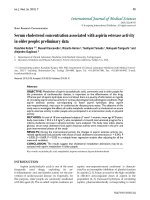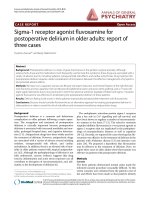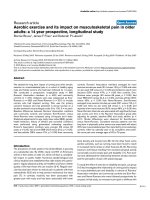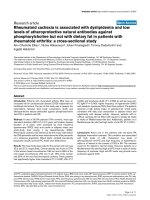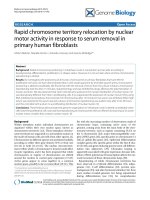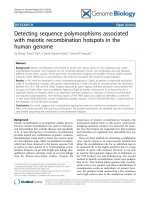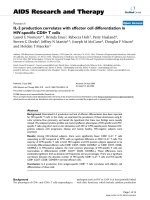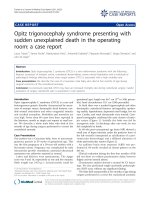Báo cáo y học: "Serum cholesterol concentration associated with aspirin esterase activity in older people: preliminary data"
Bạn đang xem bản rút gọn của tài liệu. Xem và tải ngay bản đầy đủ của tài liệu tại đây (241.33 KB, 4 trang )
Int. J. Med. Sci. 2010, 7
90
I
I
n
n
t
t
e
e
r
r
n
n
a
a
t
t
i
i
o
o
n
n
a
a
l
l
J
J
o
o
u
u
r
r
n
n
a
a
l
l
o
o
f
f
M
M
e
e
d
d
i
i
c
c
a
a
l
l
S
S
c
c
i
i
e
e
n
n
c
c
e
e
s
s
2010; 7(2):90-93
© Ivyspring International Publisher. All rights reserved
Short Research Communication
Serum cholesterol concentration associated with aspirin esterase activity
in older people: preliminary data
Kazuhiko Kotani
1
, Russell Caccavello
2
, Ricardo Hermo
2
, Toshiyuki Yamada
1
, Nobuyuki Taniguchi
1
and
Alejandro Gugliucci
2
1. Department of Clinical Laboratory Medicine, Jichi Medical University, Tochigi, Japan
2. Glycation, Oxidation and Disease Laboratory, Touro University-California, Vallejo, CA, USA
Corresponding author: Kazuhiko Kotani, MD, PhD, Department of Clinical Laboratory Medicine, Jichi Medical Univer-
sity, 3311-1 Yakushiji, Shimotsuke-City, Tochigi 329-0498, Japan. Tel: +81-285-58-7386, Fax: +81-285-44-9947, E-mail:
Received: 2010.03.09; Accepted: 2010.05.09; Published: 2010.05.10
Abstract
OBJECTIVE: Metabolism of aspirin (acetylsalicylic acid), commonly used in older people for
the prevention of cardiovascular disease, is important to the effectiveness of this drug.
Whereas part of aspirin hydrolysis occurs in blood, there is a paucity of information in regards
to circulating aspirin esterase activity in various physiological and pathological conditions. High
aspirin esterase activity, corresponding to faster aspirin hydrolysis (thus aspirin
non-responsiveness), may occur in cardiovascular disease-prone states. The objective of this
study was to investigate the effects of cardio-metabolic variables such as cholesterol on serum
aspirin esterase activity in older people who participated in an intervention study on physical
activity.
METHODS: A total of 18 non-medicated subjects (7 men/11 women, mean age 67.8 years,
body mass index = 23.4 ± 3.3 kg/m
2
), who completed a 3-month interventional program for a
mild-to-moderate increase in physical activity, were analyzed. The body mass index, plasma
glucose, serum total cholesterol and aspirin esterase activity were measured in the pre- and
post-interventional phases of the study.
RESULTS: During the interventional period, the changes in aspirin esterase activity cor-
related significantly and positively with those of total cholesterol concentrations (r = 0.542, P
= 0.020; β = 0.609, P = 0.035 in a multiple linear regression analysis after adjusting for all the
measured variables).
CONCLUSION: The results suggest that cholesterol metabolism alterations may be as-
sociated with aspirin metabolism in older people.
Key words: acetylsalicylic acid; antiplatelet; aspirin resistance; hypercholesterolemia
INTRODUCTION
Aspirin (acetylsalicylic acid) is one of the most
frequently used drugs, exploiting its an-
ti-inflammatory and anti-platelet actions for the pre-
vention of cardiovascular disease (1). Especially, for
this purpose, older people are commonly medicated
with this agent (2). The so-called ‘aspirin resistance (or
aspirin non-responsiveness) syndrome’ is characte-
rized by an incomplete inhibition of platelet function
by aspirin (2, 3). It may account for the high variability
in effective anti-coagulant doses of aspirin in the
population (2, 3). Increased hydrolysis of circulating
aspirin, pharmacokinetically corresponding to faster
Int. J. Med. Sci. 2010, 7
91
elimination of the drug from the circulation by trans-
forming it into salicylate and acetate, is thought to
participate as a causal factor in the aspirin resistance
(4, 5). Although the hepatocyte accounts for most of
aspirin catabolism, after the first pass, more than 50 %
of the aspirin still gets to the systemic circulation
where two distinct aspirin hydrolysis pathways act: a
spontaneous pH-dependent hydrolysis and an en-
zymatic hydrolysis by plasma/serum and erythrocyte
esterases (6). The circulating aspirin esterase activities
are mainly due to butyrylcholinesterase (BChE,
pseudocholinesterase) and, in part, to albumin (6).
Because of higher aspirin esterase activity lead-
ing to faster aspirin hydrolysis, the same dose of
as-
pirin in people who metabolize aspirin slowly is
more effective than in those who metabolize the
drug quickly
(4, 5)
.
There is a wide range of rates of
aspirin metabolism in the population, and ethnic and
individual variations exist (7, 8). Even for a given in-
dividual, age-related factors may be also contributory
to the range of turnover rates (8). However, despite
the universal use of aspirin, the underpinnings of the
etiology of aspirin resistance remain unclear as is the
putative relative role of peripheral (serum) and cen-
tral (hepatic) metabolism (4-6, 8).
Recently, a cross-sectional study has reported
aspirin esterase activity to be increased in type 2 di-
abetics and has shown the association to be mod-
ulated by circulating lipid metabolism (6). In addition,
aspirin resistance has been previously reported in
patients with diabetes and cardiovascular disease (4,
5). However, research on variations of aspirin esterase
activity in pathological and physiological states, in-
cluding the influences of therapeutic lifestyle modifi-
cations, is very scarce. We set out this study to explore
preliminarily the effects of cardio-metabolic variables
such as circulating cholesterol on serum aspirin este-
rase activity among older people who participated in
an intervention study on physical activity.
SUBJECTS AND METHODS
A total of 18 community-dwelling Japanese older
volunteers (7 men/11women; mean age = 67.8 ± 7.7
years [range = 56-81 years]), who were not current
smokers, not on any medication and had not been
diagnosed to have cardiovascular, renal, kidney,
thyroid and nutritional diseases, were recruited into a
3-month interventional program for health promo-
tion. The program, which focused on the health bene-
fits of a mild-to-moderate increase in physical activity,
included monthly explanatory and motivational
classes to increase physical activity such as walking
and to instruct on the appropriate methods. The Jichi
Medical University ethics committee approved the
present study and each subject gave informed con-
sent.
The body mass index (BMI) was calculated as the
weight divided by the square of the height measured
in light indoor clothing without shoes. Serum total
cholesterol and plasma glucose were enzymatically
determined. Serum aspirin esterase activity was
measured kinetically by a modification (optimized in
our laboratory) of the procedure described initially by
Sorensen (9). The reagent buffer contained Tris-HCl
(0.6 mol/L) and CaCl
2
(0.4 mol/L) in pH 7.6-7.7. Sub-
strate was 555 mmol/L of acetylsalicylic acid (1g in 10
mL 100 % ethanol was used as the mother solution).
Briefly, 15 µL of serum sample was pipetted per well
(in duplicate) into a 96 well UV Flat bottom Plate
(Thermo 8404). Substrate was extemporaneously di-
luted 1 in 50 into reagent buffer, and then 200 μL of
this final substrate solution was added per well with a
multi-channel pipette. The runs were blanked against
reagent (to control for spontaneous hydrolysis of
acetylsalicylic acid). Plates were placed in a tempera-
ture-controlled plate reader SpectraMax UV from
Molecular Devices, and samples were kinetically read
at 300 nm, 37°C for 15 min, every 57 sec. Data were
expressed in nmol of acetylsalicylic acid hydrolyzed
per minute and per milliliter (nmol/mL/min). The
intra-assay CV (coefficient of variation) is 4% and the
inter-assay 5%, respectively.
Data are shown as the mean ± standard devia-
tion or the median [interquartile range]. Wilcoxon test
was used to compare the pre- and post-interventional
values of respective measured variables. The level
changes were calculated by subtracting the
pre-interventional values from the post-intervention
values. A single linear regression analysis (Pearson’s
rank correlation test) and a multiple linear regression
analysis adjusted for confounders were used to eva-
luate the correlations between the variables. The
log-transformed values of aspirin esterase were used
in these correlation analyses because of the skewed
distribution. A value of P < 0.05 was considered to be
significant.
RESULTS
The intervention on physical activity reduced
weakly but significantly the BMI levels (23.4 ± 3.3
kg/m
2
at baseline to 23.1 ± 3.0 in post-intervention, P
= 0.037). The averaged levels of other measured va-
riables between pre- and post-intervention were un-
changed at statistical significant levels: 5.7 ± 1.1 to 5.8
± 1.1 mmol/L in total cholesterol, 5.6 ± 0.8 to 5.5 ± 1.1
mmol/L in glucose, 41.4 [36.0-50.0] to 39.8 [34.6-48.1]
nmol/mL/min in aspirin esterase activity. At baseline
Int. J. Med. Sci. 2010, 7
92
(pre-intervention), aspirin esterase activity levels
were correlated significantly and inversely to age (r =
-0.569, P = 0.014). After adjustment for sex, aspirin
esterase had a significant positive correlation with age
(r = -0.548, P = 0.020), but the significance of this cor-
relation was lost after adjusting for sex and BMI (r =
-0.406, P = 0.113). The results were not affected by
adjustment for total cholesterol and glucose levels.
During the intervention period, the changes in
aspirin esterase activity levels were correlated signif-
icantly and positively with those of total cholesterol
concentrations (Table 1). Moreover, both variables
showed a significantly and independently positive
correlation after the adjustments for age (r = 0.534, P =
0.021), age and sex (r = 0.475, P = 0.035) as well as age,
sex and the changes in BMI (r = 0.618, P = 0.018). The
results on the significant, independent and positive
correlation between total cholesterol and aspirin es-
terase were not affected by adjustment for all the
measured variables (Table 1).
Table 1: The correlation between the change in the levels
(∆ values) of aspirin esterase and the other variables during
an intervention study period.
Variables r (P value) β (P value)
For Δ aspirin esterase (nmol/mL/min)
Age (years) -0.276 (0.268) -0.389 (0.100)
Sex (men) 0.352 (0.152) 0.306 (0.173)
Δ Body mass index (kg/m
2
) -0.154 (0.542) 0.295 (0.269)
Δ Total cholesterol (mmol/L) 0.542 (0.020)* 0.609 (0.035)*
Δ Glucose (mmol/L) 0.249 (0.320) 0.022 (0.922)
r: correlation coefficient of single linear regression analysis, β: cor-
relation coefficient of multiple linear regression analysis adjusted
for all the listed variables. Age in the pre-intervention was used as
age-variable. The level changes (Δ values) were calculated by sub-
tracting the pre-interventional values from the post-interventional
values. Aspirin esterase is tested after a log-transformation. Signi-
ficance level: * P < 0.05.
DISCUSSION
The present study’s main finding is that the
changes in serum total cholesterol concentrations are
clearly associated with those of aspirin esterase activ-
ity during a period of physical activity modification in
an older population. This finding suggests cholesterol
metabolism alterations may be important in media-
tion of aspirin metabolism among older people. A
recent report has shown that greater aspirin hydroly-
sis can be associated with decreased cholesterol levels
of high-density lipoprotein in type 2 diabetics (6).
Although our present results are not strictly compa-
rable to those of this previous report since that evi-
dence was obtained in diabetics, both studies poten-
tially seem to bring our attention to the notion that
aspirin hydrolysis rates may be linked to cholesterol
metabolism (6). Whereas the molecular mechanisms
underlying the modulation of circulating aspirin es-
terase activity remain to be elucidated, our data
showing its significant correlations with the changes
in cholesterol concentrations may open new avenues
for exploration of aspirin metabolism. Our present
results of improvement of aspirin effect with de-
creased total cholesterol may partly account for
non-effectiveness of aspirin in cardiovascular disease
among patients with concurrent increases of total
cholesterol levels (4, 5); thus, emphasizing the clinical
importance of control of total cholesterol with a
mild-to-moderate increase of physical activity among
such patients.
While age-related reductions in the activities of
several enzymes are known (2), data regarding the
correlation of age to aspirin esterase are inconsistent
(2, 10-12). Some studies reported a decrease of aspirin
esterase in unhealthy, frail older subjects (10-12). Our
present results at baseline only showed an inverse
correlation of age to aspirin esterase activity, but the
present study population was not frail, and BMI was
also a confounder of this correlation. BMI is a surro-
gate clinical marker for various common clinical syn-
dromes; thus, more research is needed to ascertain its
role on the effects of aging on aspirin metabolism.
This study had the limitation of a small sample
size and a short-term interventional period. In addi-
tion, we did not measure circulating albumin and
BChE. Nevertheless, albumin has a very small con-
tribution to the whole circulating aspirin esterase ac-
tivity as compared to that of BChE (8), and our study
population did not include subjects with malnutrition
nor there were any with nutritional modifications
during the interventional period. More studies with
larger sample sizes and longer follow-up as well as
including BChE measurement and nutritional as-
sessment will be considered in the future.
In summary, we found a significant and positive
association of changes in circulating total cholesterol
with those of serum aspirin esterase activity in an
older population that participated in a physical activ-
ity modification program. Although aspirin metabol-
ism is probably multi-factorial, the association with
cholesterol metabolism has merits for further inves-
tigations.
ACKNOWLEDGEMENTS
This study was supported in part by a
Grant-in-Aid for the Scientific Research from the
Ministry of Education, Culture, Sports, Science, and
Technology of Japan (K.K), the Foundation for the
Development of the Community, Japan and Touro
University-California, USA. The authors are grateful
to Dr. Tukulito Sakayama for critical reading of the
Int. J. Med. Sci. 2010, 7
93
manuscript.
CONFLICT OF INTEREST
We have no conflict of interest to declare.
REFERENCES
1. Schrör K. Antithrombotic drugs in vascular medicine: a histor-
ical perspective. Semin Vasc Med 2003; 3: 97-105.
2. Abou-Hatab K, O'Mahony MS, Patel S, et al. Relationship be-
tween age and plasma esterases. Age Ageing 2001; 30: 41-5.
3. Seymour RA, Weldon M, Kelly P, et al. An evaluation of buf-
fered aspirin and aspirin tablets in postoperative pain after
third molar surgery. Br J Clin Pharmacol 1992; 33: 395-9.
4. Watala C, Golanski J, Pluta J, et al. Reduced sensitivity of
platelets from type 2 diabetic patients to acetylsalicylic acid
(aspirin)-its relation to metabolic control. Thromb Res 2004; 113:
101-13.
5. Golański J, Chłopicki S, Golański R, et al. Resistance to aspirin
in patients after coronary artery bypass grafting is transient:
impact on the monitoring of aspirin antiplatelet therapy. Ther
Drug Monit 2005; 27: 484-90.
6. Gresner P, Dolník M, Waczulíková I, et al. Increased blood
plasma hydrolysis of acetylsalicylic acid in type 2 diabetic pa-
tients: a role of plasma esterases. Biochim Biophys Acta 2006;
1760: 207-15.
7. Williams FM, Nicholson EN, Woolhouse NW, et al. Activity of
esterases in plasma from Ghanaian and British subjects. Eur J
Clin Pharmacol 1986; 31: 485-9.
8. Adebayo GI, Williams J, Healy S. Aspirin esterase activity -
Evidence for skewed distribution in healthy volunteers. Eur J
Intern Med 2007; 18: 299-303.
9. Sorensen S. Improved measurement of acetylsalicylic acid es-
terase in serum. Clin Chem 1983; 29: 491-4.
10. Williams FM, Wynne H, Woodhouse KW, et al. Plasma aspirin
esterase: the influence of old age and frailty. Age Ageing 1989;
18: 39-42.
11. Summerbell J, Yelland C, Woodhouse K. The kinetics of plasma
aspirin esterase in relation to old age and frailty. Age Ageing
1990; 19: 128-30.
12. Singh S, Nain CK, Verma M, et al. Aspirin esterases in
North-West Indians: the influence of age and nutrition. Int J
Clin Pharmacol Ther 2000; 38: 315-9.
